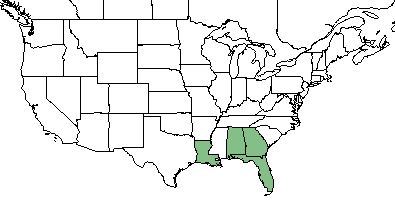Zephyranthes treatiae
| Zephyranthes treatiae | |
|---|---|

| |
| Photo by John Gwaltney hosted at Southeastern Flora.com | |
| Scientific classification | |
| Kingdom: | Plantae |
| Division: | Magnoliophyta - Flowering plants |
| Class: | Liliopsida - Moncots |
| Order: | Liliales |
| Family: | Liliaceae |
| Genus: | Zephyranthes |
| Species: | Z. treatiae |
| Binomial name | |
| Zephyranthes treatiae S. Watson | |

| |
| Natural range of Zephyranthes treatiae from USDA NRCS Plants Database. | |
Common Name(s): zephyrlily,[1][2] Treat's zephyr-lily[2]
Contents
Taxonomic Notes
Synonym(s): Atamosco treatiae (S. Watson) Greene; Z. atamasca (Linnaeus) Herbert var. treatiae (S. Watson) Meerow; Z. atamasco (L.) Herb. [1][2][3]
Description
Z. treatiae is a monoecious perennial forb/herb[2] that can reach heights of 10 in (0.25 m).[4] They are typically found singly or loosely clumped[5] and can hybridize with species of Z. atamasco.[6]Perianth tube > 1cm long, segments spreading. Leaves1-2 cm wide.[7]
Distribution
It can be found in southern portions of Georgia, south to central penisular Florida,[1][2] with occurrences in Alabama and Louisiana. In Florida, Z. treatiae is listed as a threatened species.[2][8]
Ecology
Habitat
Zephyranthes treatiae has been found in wet savannas[1], pine flatwoods, low pinelands, live oak woodlands, swamps, and xeric pine plantations.[5][9][10][11]
It is also found in disturbed areas including mowed sod near flatwoods and roadsides.[12][13]
Phenology
It flowers between January and April, peaking in March,[4][14] and producing white flowers that fade to pink.[4] Flowers are broadly funnelform with reflexed perianth segments and exserted stigmas.[5]
Fire ecology
Populations of Zephyranthes treatiae have been known to persist through repeated annual burning.[15]
Mentioned as "Flowering in the spring, especially after fires".[16]
Herbivory and toxicology
The bulb of Zephyranthes treatiae is toxic, and if ingested will cause severe digestive irritation. This species is known to kill both cattle and deer.[17] Digesting charcoal may relieve symptoms.[18]
Conservation, cultivation, and restoration
Cultural use
Photo Gallery
References and notes
- ↑ 1.0 1.1 1.2 1.3 Weakley A. S.(2015). Flora of the Southern and Mid-Atlantic States. Chapel Hill, NC: University of North Carolina Herbarium.
- ↑ 2.0 2.1 2.2 2.3 2.4 2.5 USDA, NRCS. (2016). The PLANTS Database (http://plants.usda.gov, 15 December 2017). National Plant Data Team, Greensboro, NC 27401-4901 USA.
- ↑ Burrows, G.E., Tyrl, R.J. 2001. Toxic Plants of North America. Iowa State Press.
- ↑ 4.0 4.1 4.2 Plant database: Zephyranthes treatiae. (15 December 2017).Lady Bird Johnson Wildflower Center. URL: https://www.wildflower.org/plants/result.php?id_plant=ZETR
- ↑ 5.0 5.1 5.2 Flagg R. O. and Smith G. L. (2008). Delineation and distribution of Zephyranthes species (Amaryllidaceae) endemic to the southeastern United States. Castanea 73(3):216-227.
- ↑ Broyles S. B. and Wyatt R. (1991). The breeding system of Zephyranthes atamasco (Amaryllidaceae). Bulletin of the Torrey Botanical Club 118(2):137-140.
- ↑ Austin D. 2000 Discovering Florida's Ethnobotany with Dr. Dan Austin Rain Lilies Palmetto 20(3):14-16
- ↑ Flagg R. O. (2014). Rain-lilies (Amaryllidaceae) of U.S.A. and Mexico. SE Biology 61(1):84-100.
- ↑ Angelo State University Herbarium accessed using Southeastern Regional Network of Expertise and Collections (SERNEC) data portal. URL: http://sernecportal.org/portal/collections/index.php Last accessed: June 2021. Collectors: Stanely D. Jones. States and Counties: Florida: Wakulla. Texas: Leon.
- ↑ Arizona State University Vascular Plant Herbarium accessed using Southeastern Regional Network of Expertise and Collections (SERNEC) data portal. URL: http://sernecportal.org/portal/collections/index.php Last accessed: June 2021. Collectors: H.H. Hume. States and Counties: Florida: Polk.
- ↑ Carnegie Museum of Natural History Herbarium accessed using Southeastern Regional Network of Expertise and Collections (SERNEC) data portal. URL: http://sernecportal.org/portal/collections/index.php Last accessed: June 2021. Collectors: A.H. Curtiss. States and Counties: Florida: Duval.
- ↑ Austin D. 2000 Discovering Florida's Ethnobotany with Dr. Dan Austin Rain Lilies Palmetto 20(3):14-16
- ↑ Eastern Kentucky University, Ronald L. Jones Herbarium accessed using Southeastern Regional Network of Expertise and Collections (SERNEC) data portal. URL: http://sernecportal.org/portal/collections/index.php Last accessed: June 2021. Collectors: V. E. McNeilus. States and Counties: Georgia: Echols.
- ↑ Nelson G. (15 December 2017) PanFlora. Retrieved from gilnelson.com/PanFlora/
- ↑ Platt, W.J., R. Carter, G. Nelson, W. Baker, S. Hermann, J. Kane, L. Anderson, M. Smith, K. Robertson. 2021. Unpublished species list of Wade Tract old-growth longleaf pine savanna, Thomasville, Georgia.
- ↑ Austin D. 2000 Discovering Florida's Ethnobotany with Dr. Dan Austin Rain Lilies Palmetto 20(3):14-16
- ↑ Burrows, G.E., Tyrl, R.J. 2001. Toxic Plants of North America. Iowa State Press.
- ↑ Burrows, G.E., Tyrl, R.J. 2001. Toxic Plants of North America. Iowa State Press.